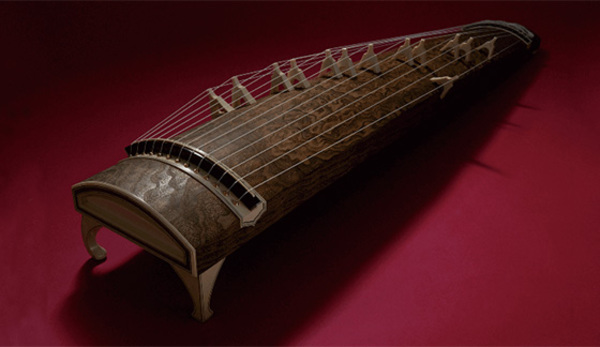
- Other crafts
- Tokyo
Tokyo Koto (Japanese Harp) Tokyo Koto
Charming those who listen to the beautiful high tones and clear sound quality
A Japanese instrument loved by koto musicians of different schools
Description
What is Tokyo Koto (Japanese Harp) ?
The koto was introduced from China as an instrument for court music. Then around the 16th century, the Tsukushi Goto was made in Japan which became the base of the Japanese koto today. The koto was known familiarly as part of the Kyoto culture, but in the mid-Edo period (1603 – 1868), it became popular in Edo (current Tokyo) as well. Kengyo Yamada (Toyoichi), a koto musician who was successful during the Edo period, composed many musical pieces for the koto, and as a result, the production of koto increased. The characteristics of Tokyo Koto are the strong sound and clear sound quality. The strength of the sounds can be increased by changing the length and thickness of the koto and the warp of the base wood. Clear sounds can be played using a large koto plectrum. The production process of the koto can also be arranged depending on the player's capabilities and skills. The artisan can adjust the carving of the body of the koto precisely so that the musician who ordered the koto can play his ideal music. There are many koto schools such as the Yamada school and Ikuta school, but the Tokyo Koto is used widely regardless of the school. Tokyo Koto is currently being produced in the Bunkyo ward, Setagaya ward, Shibuya ward etc.
History
When the koto was introduced to Edo from Kyoto and became an instrument known to the general public, its role as an instrument changed. Up to then, the koto was used for accompanying the shamisen or other instruments played in court music, but it became the main instrument in the music composed by Kenko Yamada. Yamada's new style of music where the koto was played while singing became very popular in Edo. As this style of music for koto developed, a koto called the "Yamada Koto", which is the original form of the Tokyo Koto was produced. Production of koto in Edo increased and improvements were made so that high notes could by played depending on the type of music. This became the current Tokyo Koto. By the mid 19th century, the koto was produced with the same techniques, skills and material used today. For the body of the Tokyo Koto, paulownia wood, red sandalwood and rosewood were used, and silk threads were used to make the strings. Tokyo Koto is one of the Japanese instruments played widely even today, from professional musicians to students.
General Production Process
- 1. Making the body
The wood material (paulownia wood etc.) is dried and shaved to bring out the wood grain and to form a gently curved surface.
The backside is also shaved using an adze, and after finishing with a rounding plane called sotomaru kanna, a zigzag pattern called ayasugi is carved with a chisel. - 2. Koyaki The whole surface is seared with a hot iron heated in charcoal fire.
- 3. Producing decorative implements and assembling Decorative implements such as the kuchimae are produced. The body is engraved and the implements are installed and glued on.
- 4. Shinzauchi The shinza which is the part where the holes to put the strings through are, is attached to the shiburokuban (a fitting attached on the surface of the body) with a wooden mallet.
See more Other crafts
- Edo kiriko cut glass
- Koshu lacquered deer leather
- Kyo folding fans
- Marugame uchiwa fans
- Boshu uchiwa fans
- Gifu lanterns
- Yamaga lanterns
- Kyo uchiwa fans
- Tendo Japanese chess pieces
- Edo glass
- Edo patterned paper
- Yame lanterns
- Owari Cloisonné
- Fukuyama Koto (Japanese Harp)
- Kyo art preservation
- Banshu fly-fishing flies
- Woodblock prints
- Koshu hand-carved seals
- Edo Hyogu (Art Mountings)
- Edo tortoise shell crafts
- Etchu Fukuoka Sedge Hats
- Gifu Japanese Umbrellas
- Nagasaki tortoise shell crafts
- Nagoya Sekku Kazari
- Sanshin
- Tokyo Koto (Japanese Harp)
- Tokyo Shamisen
See items made in Tokyo
- Edo kiriko cut glass
- Edo wood joinery
- Edo glass
- Murayama-oshima tsumugi silk
- Tokyo silverware
- Edo patterned paper
- Tokyo fine-patterned dyeing
- Edo bamboo fishing rods
- Tama brocade
- Hachio island silk
- Woodblock prints
- Tokyo textiles
- Edo-sekku doll
- Edo Hyogu (Art Mountings)
- Edo Oshi-e Pictures on Embossed Fabric
- Edo tortoise shell crafts
- Tokyo Honzome Chusen
- Tokyo Koto (Japanese Harp)
- Tokyo Plain Dyeing
- Tokyo Shamisen
- Tokyo antimony craft































































































































































































































































































